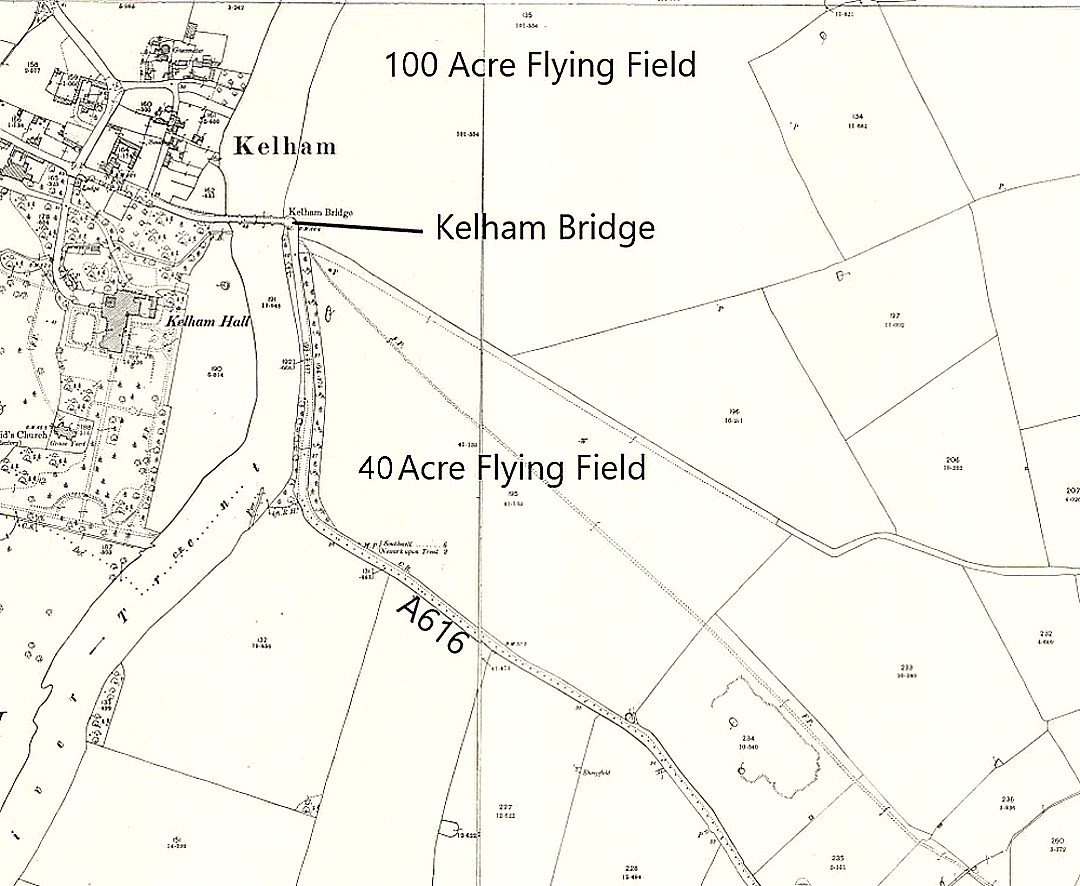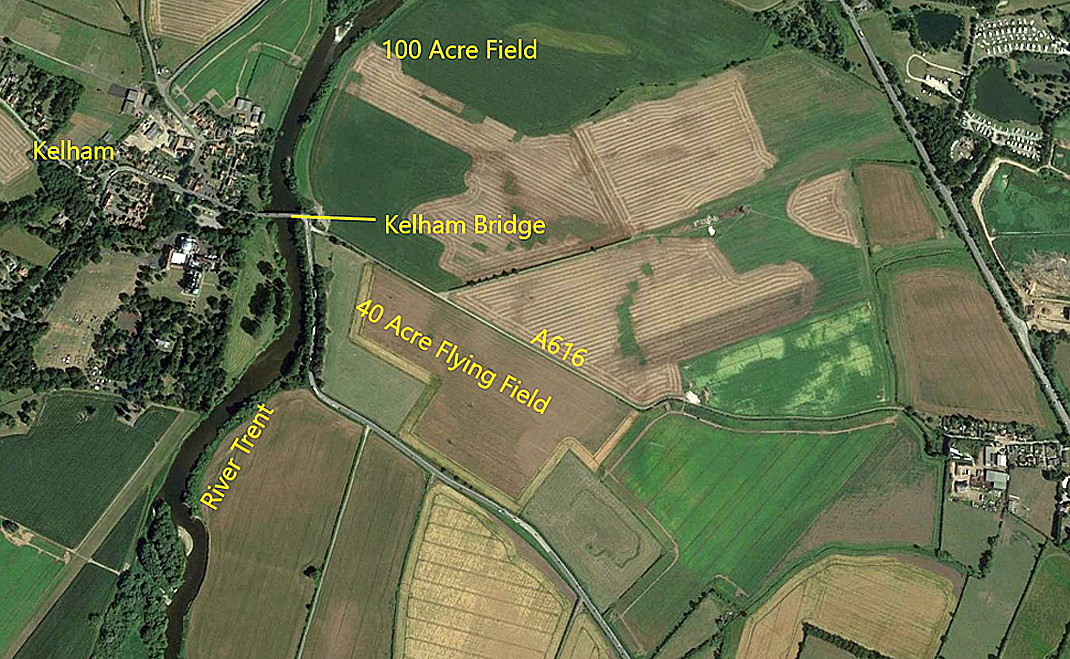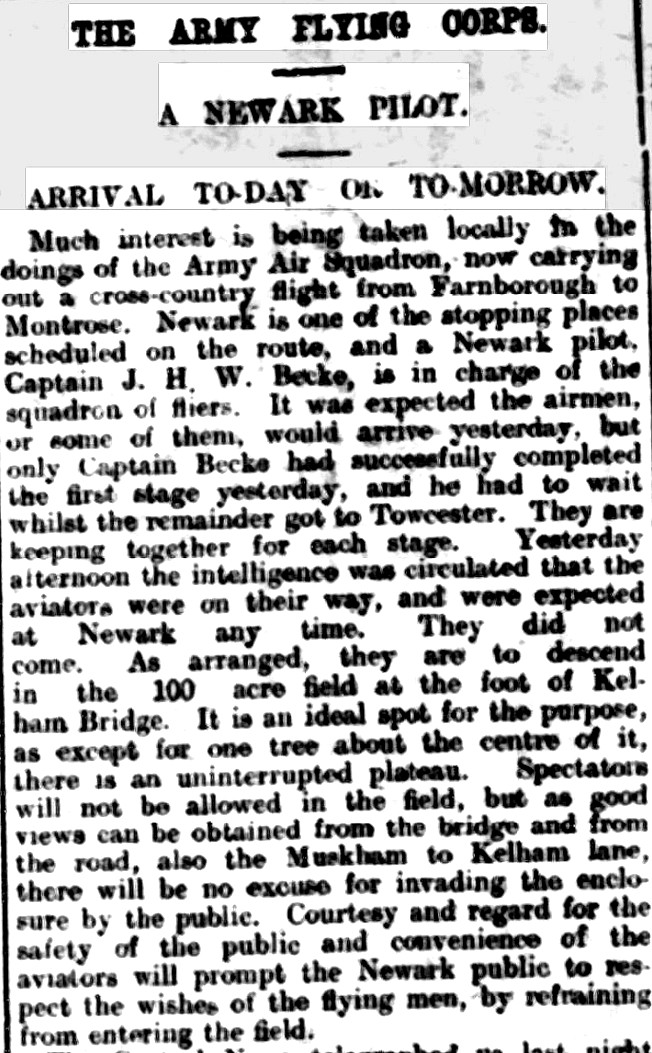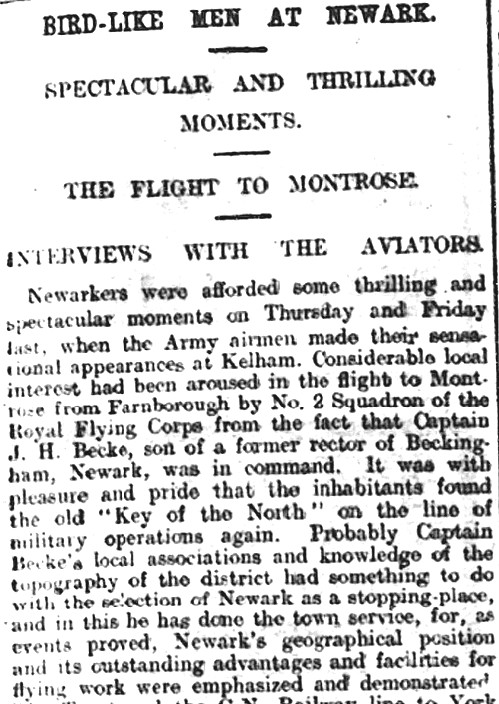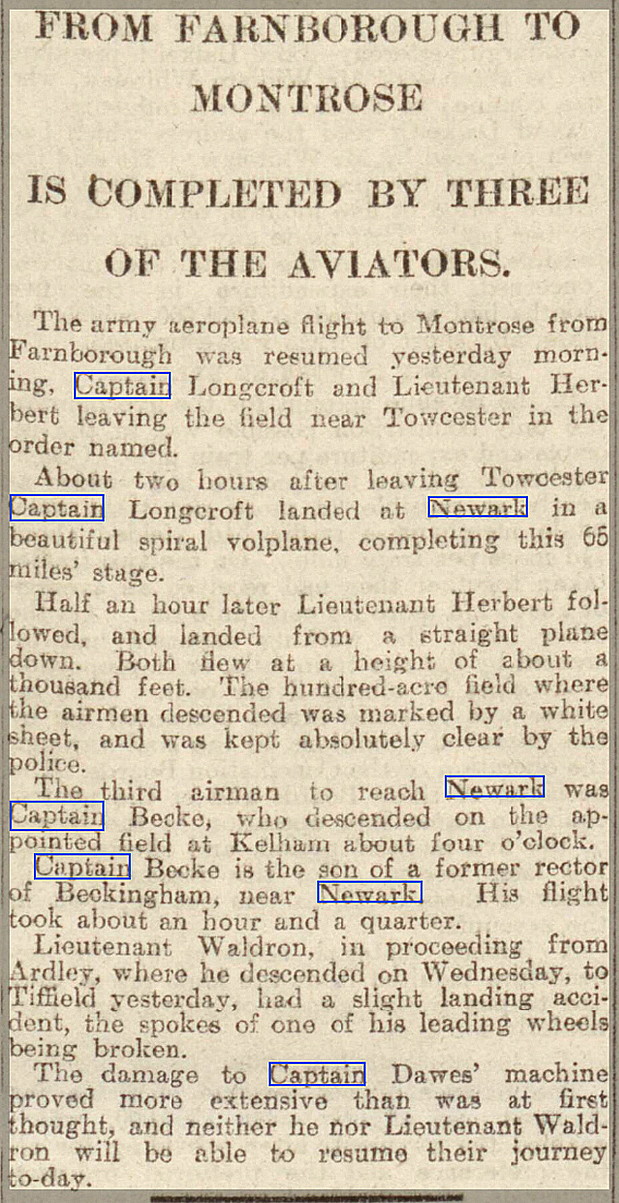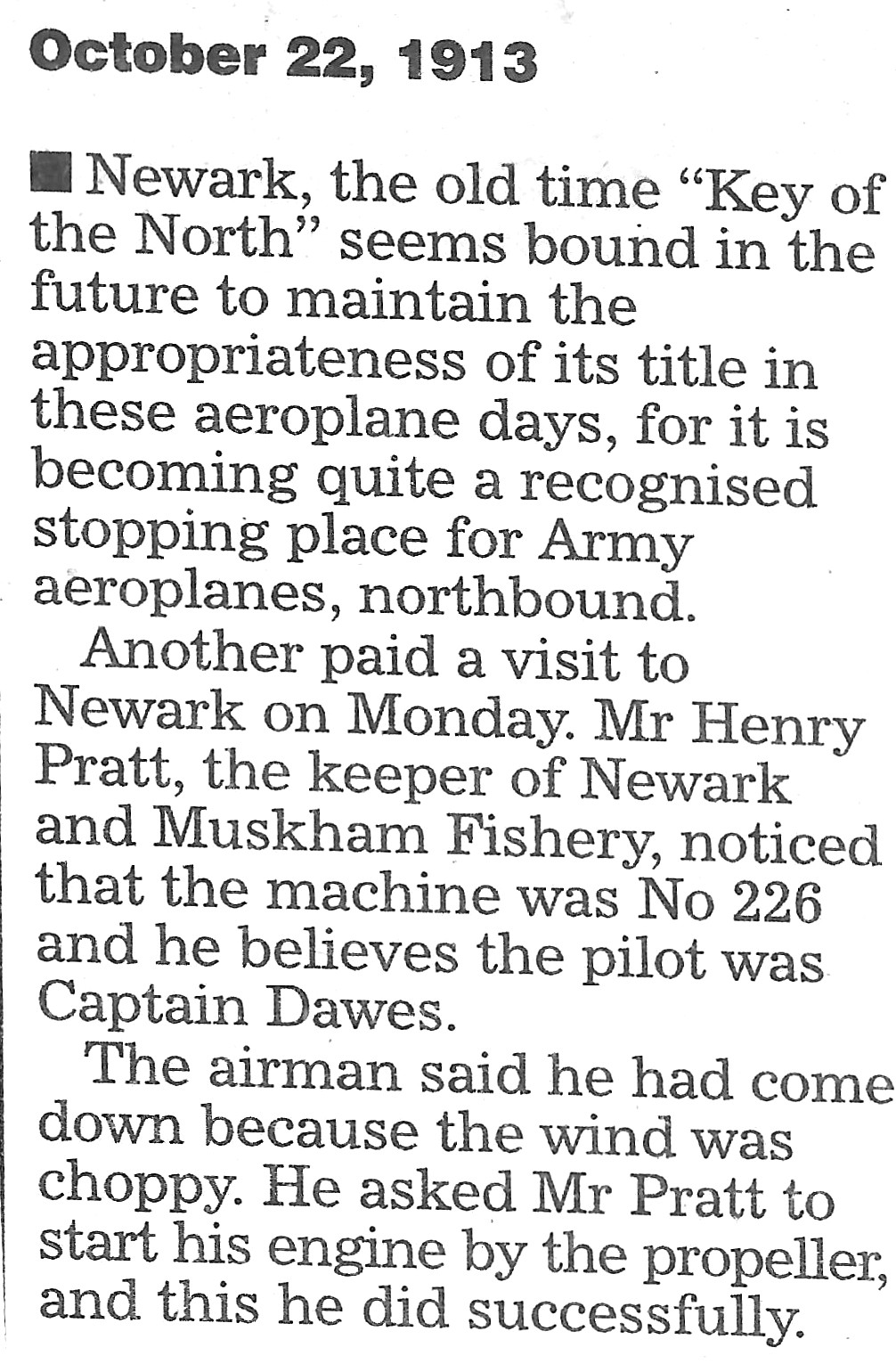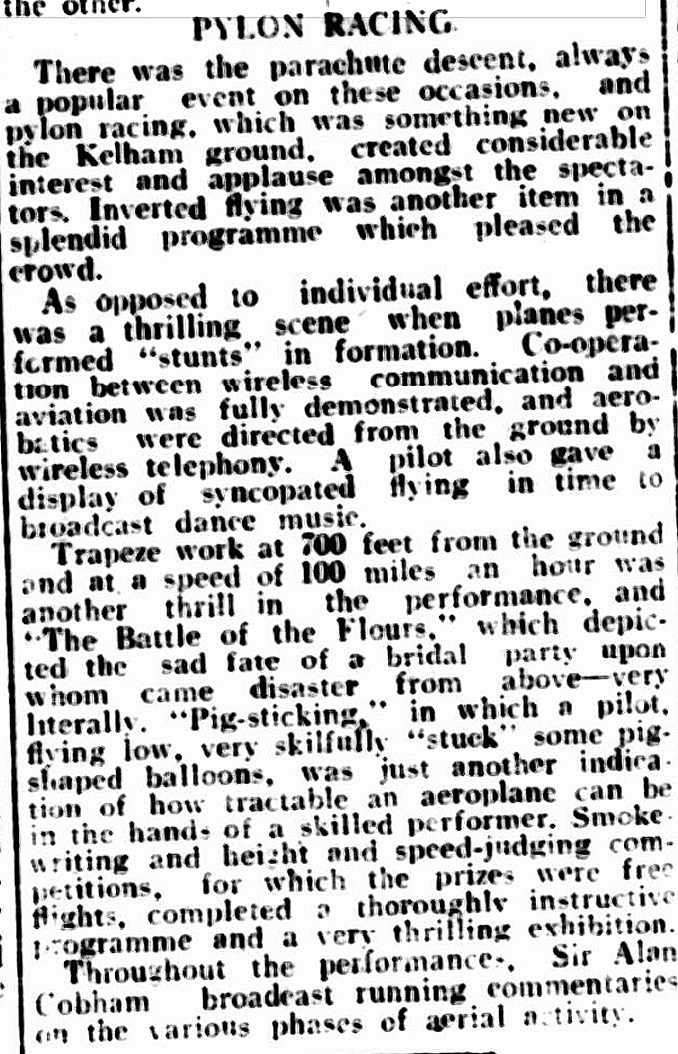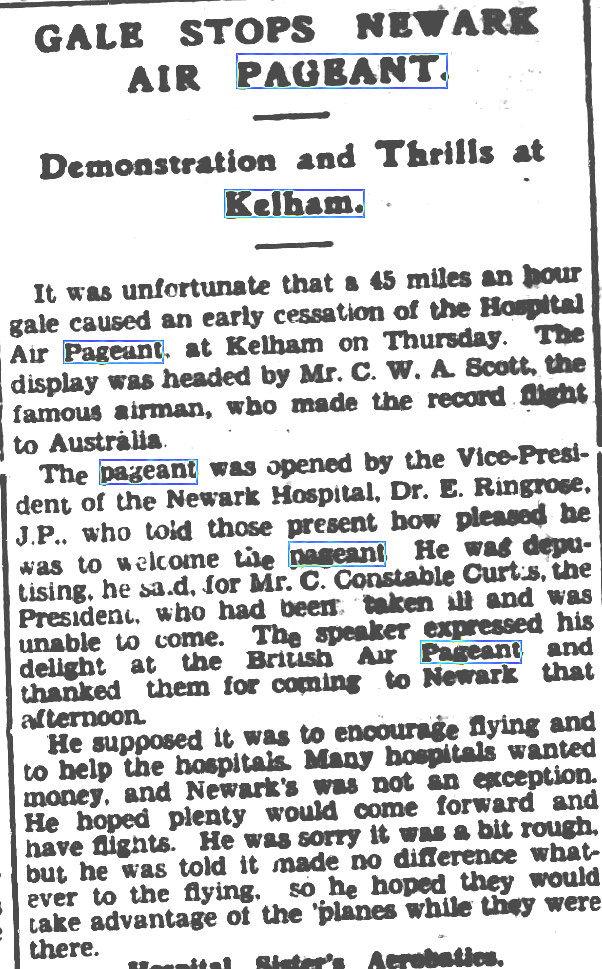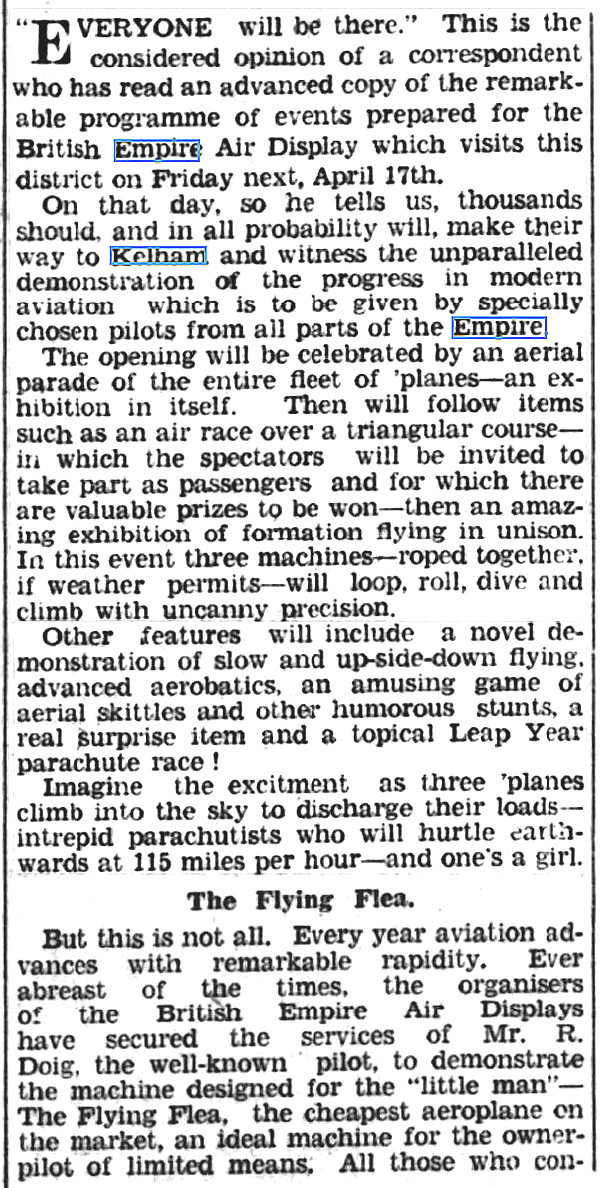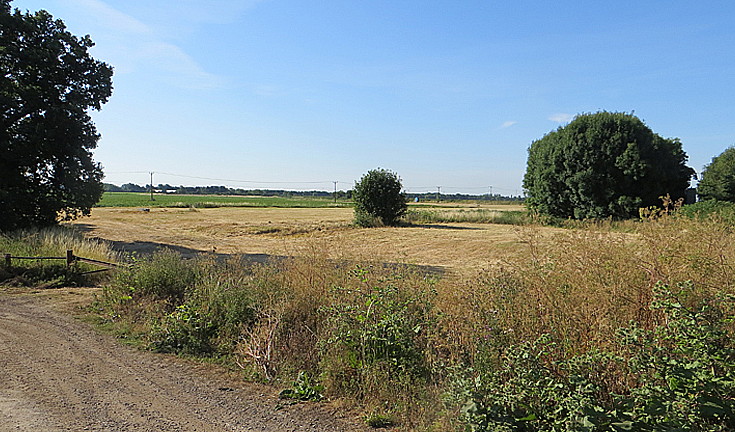Kelham Bridge
KELHAM BRIDGE: Temporary Landing Ground & Temporary aerodrome (Aka KELHAM)
NOTE: This local area just NW of Newark town centre appears to have been used on occassions from 1911 until just before WW2. We have Mike Holder, a great friend of this 'Guide', to thank for both finding the locations and providing all the maps, articles and pictures.
1911: Temporary Landing Ground used as the NEWARK staging post during the Daily Mail Air Race. This particular site, also known as 40 ACRES, was used by the English pilot James Valentine on the 26th July 1911.
A MICHAEL T HOLDER GALLERY
Note: The two very poor photographs were both published in the Newark Advertiser on the 26th July 1911. See two part article text below.
Note: The other article was published in the Hucknall Morning Star and Advertiser on the 28th July 1911.
1913: Temporary Landing Ground: (Aka 100 ACRE FIELD)
Operated by: No.2 Squadron, Royal Flying Corps
Location: About 1.5nm NW of Newark town centre
Period of operation: 20th & 21st February 1913
A SECOND MICHAEL T HOLDER GALLERY
Article One was published in the Newark Advertiser on the 19th February 1913.
Article Two, in two parts, was published in the Newark Advertiser on the 26th February 1913.
Article Three was published in the Dundee Courier on the 21st February 1913. Article Four was published in the - wait for it - Montrose, Arbroath and Brechin Review, and, Forfar and Kincardinshire Advertiser.
Article Five, giving the itinerary of this aerial expedition, was published in the Aberdeen Press and Journal on the 27th February 1913. The area view is from my Google Earth © derived database.
A BONUS ITEM
This short article, published in the Newark Advertiser, was kindly sent to Mike Holder by the Newark Air Museum later on. It clearly indicates that RFC machines, transiting from north to south and vice versa, were using this location. In this case on the 22nd October 1913. I have tried to ascertain what type of aeroplane No.226 was.......and failed. Any ideas?
NOTES: For a more detailed account of the circumstances regarding this rather extraordinary series of flights, please look at the listing for TIFFIELD. As an aside I was surprised to see that the reporter of the itinerary in Article Five above, clearly had no idea about the difference between airships and aeroplanes, despite both having been flown around the UK for several years.
USED AS ANOTHER VENUE (By this time: Aka KELHAM FLYING FIELD & KELHAM ESTATE AERODROME)
Without much if any doubt 100 ACRE FIELD was used later on, especially in the 1930s. For example by C D Barnard Air Tours on the 1st May 1931 and Sir Alan Cobham's National Aviation Day Display tour on the 6th June 1933. Also by the British Hospitals Air Pageant tour on the 17th August 1933, and lastly by the British Empire Air Display tour on the 17th April 1936.
Here again, Mike Holder has very kindly researched the subject looking for newspaper reports.
BERKSHIRE AVIATION - 18th to 30th March 1921, 4th to 16th March 1926 and 20th May 1928
Note: It was common practise in the 1920s and 1930s for touring operators to negotiate from a farmer, the best deal for use of a suitable field. And indeed, there are many examples of different fields being used in very close proximity over several years. So, for the purposes of this 'Guide', the venues of MUSKHAM ROAD and GREAT NORTH ROAD are included here, both being quite close to the KELHAM BRIDGE, 100 ACRES location.
Advert One was published in the Newark Advertiser on the 9th March 1921. In those days the A1 Great North Road passed through Newark town centre. The Notice was published, also in the Newark Advertiser, but on the 23rd March giving the venue as MUSKHAM ROAD which appears to be just west of the old A1 trunk road.
Advert Two was published in the Newark Advertiser on the 3rd March 1926. The article was published in the Newark Herald on the 13th March 1926.
Advert Three was published in the Newark Herald on the 19th May 1928. I find this of particular interest because it appears it was a one day venue, on the 20th May. Therefore probably having three or more aeroplanes involved? If correct, this is I think, perhaps the first example of a one day event which later became the normal procedure after the early 1930s.
C D BARNARD AIR TOURS - 1st May 1931
Article One was published in the Nottingham Evening Post on the 20th April 1931. Article Two was published in the Nottingham Journal on the 25th April 1931. Article Three was published in the Newark Advertiser on the 6th May 1931.
NOTE: I may well be mistaken of course, but this is the first mention I can remember of the term "Air Circus" being used? Within a fairly short period, the press especially had coined the term for such displays - "Flying Circus'. A term which Sir Alan Cobham detested!
SIR ALAN COBHAM'S NATIONAL AVIATION DAY DISPLAY - 6th June 1933
Article One was published in the Newark Herald on the 27th May 1933. Article Two in three parts was also published in the Newark Herald, but this time on the 10th June 1933.
BRITISH HOSPITALS AIR PAGEANT - 17th August 1933
Article One was published in the Newark Herald on the 12th August 1933.
Article Two was published in the Newark Advertiser on the 23rd August 1933.
SKY DEVILS - 11th May 1934
This Notice was published in the Newark Advertiser on the 2nd May 1934.
JUBILEE AIR DISPLAY - 14th May 1935
This article, in two parts, was published in the Newark Advertiser on the 8th May 1935.
BRITISH EMPIRE AIR DISPLAY - 17th April 1936
This article was published in the Newark Advertiser on the 15th April 1936.
MODEL FLYING
This article was published in the Newark Advertiser on the 23rd July 1947.
NOTES: Since the very beginning of powered aeroplanes, 'exhibitions of flying' as displays were usually called, drew large crowds - even for just one machine and its aviator - as pilots were also usually referred to as. After World War One the concept of visiting various places offering joy rides became very popular, often with just one to two aircraft participating. Often staying in one location for a week or more at inland venues. Popular seaside resorts often had companies staying much longer, even for the season, with floatplanes commonly used.
What I at least, find particularly interesting, is that the idea of mounting displays with a fleet of aircraft, usually staying for just one day, two at most, (and offering joy rides), coincided with the Great Depression. (1929 to 1939). As far as I am aware, the very intensive tours by the largest companies, mainly occurred in the U.K.? Generally from mid April until early October. Sir Alan Cobham's National Aviation Day Display Tours surpassed by far all the other operators.
His visit here on the 6th June 1933 was the 48th venue for his No.1 Tour. This started at CENTRAL PARK, Dagenham in ESSEX on the 14th/15th April and finished at CHERTSEY LANE, Staines in MIDDLESEX on the 8th October. It was planned to visit 116 venues and as far as we know, nearly all, if not all venues (?), were visited on time. This Tour included visiting the Irish Republic twice.
The No.2 Tour was planned to visit 161 venues, staying on the mainland. Sir Alan, a renowned 'work-a-holic' did not provide any rest days for his airmen. It appears that he regarded a two day stay, (and there were few of these), as providing respite enough. Likewise in providing a day each to fly to and from Ireland for the No.1 Tour.
LAST BUT CERTAINLY NOT LEAST
In 2022, when Mike Holder was searching for information, maps etc, he was in contact with Howard Heeley, the Secretary for the Newark Air Museum. He very kindly provided these pictures of the two main flying sites are they can be seen today.
In producing this 'Guide' it has been very humbling for me to find so many kind and generous people more than happy to help. More, many more, than I could ever have hoped for. My sincere thanks to everybody.
We'd love to hear from you, so please scroll down to leave a comment!
Leave a comment ...
Copyright (c) UK Airfield Guide














